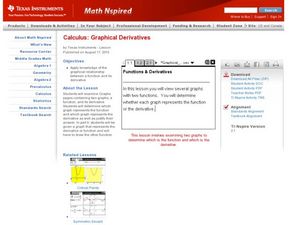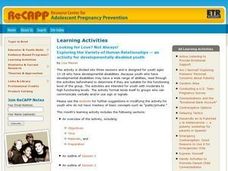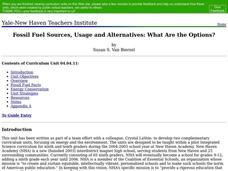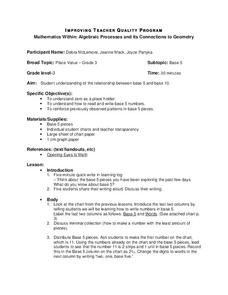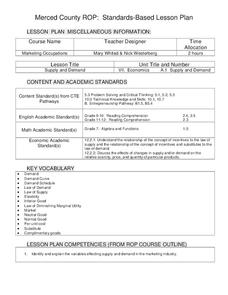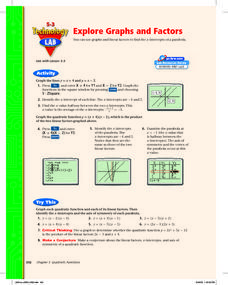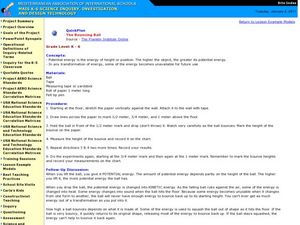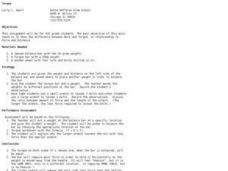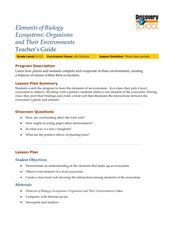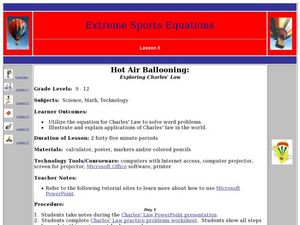Curated OER
US Geography, The Blues
This lesson enables teachers to use blues styles and performers to think about various geographical regions of the United States. By studying different blues styles from the Mississippi Delta, Texas, and the Piedmont region of the...
Curated OER
Medieval Catapults
Students design and build a working catapult or trebuchet to explore the concepts of force, motion, and distance.
Curated OER
Technology-Lesson 2-Resolving Issues
Students define resolution. They explain the relationship between probe size and resolution and explain why information in three dimensions is necessary to describe the structure of an object. Research technology to the study of Cellular...
Texas Instruments
Graphical Derivatives
Pupils solve functions using the derivative. They determine the derivative of a function based on its graph, then analyze different functions and draw a relationship and conclusion based on the graph.
Curated OER
Looking for Love? Not Always! Exploring Human Relationships
Students research psychology by examining real life situations. In this human relationships lesson, students discuss the importance of respect among two people in a romantic relationship. Students examine images of people in...
Curated OER
Analogy Lesson Plans That Make Connections
With the right analogy lesson plans students can get a handle on this important, and sometimes difficult, concept.
Curated OER
Tete a Tete: Portraits by Henri Cartier-Bresson
Students examine the relationship of a portrait and the subject it represents. They discover the photographs of Henri Cartier-Bresson and discuss. They also read about Cartier-Bresson's philosophy.
Curated OER
America Poems
Students examine examples of how other Americans have expressed their feelings about America through songs and poetry, and write their own poems to express their relationship with America.
Curated OER
Fossil Fuel Sources, Usage and Alternatives: What Are the Options?
Young scholars examine the relationship between energy and the environment. In groups, they participate in experiments to discover the law of thermodynamics and the differences between potential, kinetic and mechanical forms of energy. ...
Curated OER
Cry Until You Laugh
Students write about the relationship between comedy and personal pain in their journals. After reading an article, they examine the Humber College school of comedy. They brainstorm difficult events in their own lives and create...
Curated OER
Dinosaur Tracks: From Stride To Leg Length To Speed
Students determine the relationship between leg length, stride length, and speed in humans and bipedal dinosaurs. They collect data and graph these human characteristics then use actual data collected from dinosaur track pads and fossils...
Curated OER
Place Value
Third graders study the relationship between base 5 and base 10. They determine zero is a place holder and how to read and write base 5 numbers. They reinforce previously observed patterns in base 5 pieces. They choose another base and...
Curated OER
Marketing Occupations
Students identify and explain the variables effecting supply and demand in the marketing industry. Then they define the terms supply and demand and graph supply and demand curves on a standard grid. Students also formulate what happens...
Curated OER
Explore Graphs and Factors
Pupils graph the factors of a quadratic as linear equations and graph the parabolic equation in factored form. Also, they investigate the relationship between the x-intercepts of the lines and the zeros of the parabola.
Curated OER
Touring Tradition
Students study about the Venezuelan government's promotion of the Dancing Devils ritual in San Francisco de Yare as a tourist attraction. They investigate a number of traditional regional events around the world to explore the...
Curated OER
The Bouncing Ball
Students use the scientific method to conduct an experiment to test how a ball bounces. In this inquiry-based physical science and scientific method lesson, students drop a ball from specified heights and record the rebound, then record...
Curated OER
How are torque and work different?
Sixth graders explore how torque and work are different. In this torque lesson plan, 6th graders will understand the relationship between torque and work as it applies to force and distance. Students will be assessed on their conclusions...
Curated OER
Building Sensitivity and Awareness
Students recognize the needs, disabilities and attitudes of seniors. For this sensitivity awareness lesson, students work with residents of a senior citizen residence and build a relationship with a senior. Students simulate the...
Curated OER
Organisms and Their Environments
Students study a local ecosystem and research the organisms to create a food web. In this ecosystem lesson, students view a video and answer questions. They visit a local ecosystem and make a list of organisms to research. Students...
Curated OER
Hot Air Ballooning: Exploring Charles' Law
Students solve word problems dealing with Charles' Law. In this Charles' Law instructional activity, students observe PowerPoint presentations concerning Charles' Law. They complete a WebQuest and describe the relationship between hot...
Alabama Learning Exchange
Writing Equations for Parallel Lines
Acquaint your class with the concept of parallel lines. Learners watch a PowerPoint presentation about how to write equations of parallel lines. Their understanding of linear equations and slope is taken a step further by the exercises...
Curated OER
Chords of a Circle
Teach how to differentiate between chords and perpendicular bisectors. In this geometry lesson, students relate the properties of chords and circle to solving right triangle. They define what makes two chords congruent in side a circle.
Curated OER
What's the Best Deal?
Young scholars explore number sense by solving consumer math problems. In this pattern identification lesson, students analyze a list of numerical and geometric patterns while predicting the future outcome. Young scholars utilize...
Curated OER
Prepositions
In this grammar activity, students learn about using prepositions in sentence writing. They then answer 12 questions regarding prepositions. The answers are on the last page of the packet.





